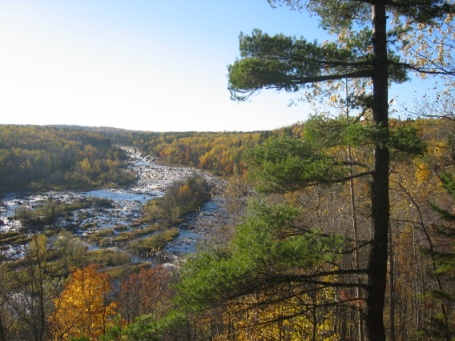We ask that you reach out to MN Governor Mark Dayton, who has stated that the decision on PolyMet will be the most momentous of his term as governor, to tell him to say no to the Sulfide Mine that threatens the St. Louis River. Governor Dayton is fluent in both the language of the heart and the balance sheet. He must hear from us of the value of the St. Louis River and its watershed and understand that stopping PolyMet and other sulfide mining in Minnesota’s watery north is of critical importance to all creatures on this earth and in particular those in Minnesota’s northeast.
For many reading this, a poetic description of a river is a convincing testimonial to its value; others need only kneel beside a stream to grasp the value of the watershed. But for some a different language is spoken and we must translate our understanding of a river’s value into dollars. The value of the St. Louis River watershed seemed to me to be incalculable, an immense and powerful river, tea stained with natural tannins, lush wetlands, silvery fish, buzzing bees, and lands where ancient trees lay cool in the earth. The river flows from a shallow wild rice lake near our home, past abandoned and struggling modern mining towns, through a tribal community with roots in the region thousands of years old. The St. Louis River pours into a rare freshwater estuary, then into Great Lake Superior; all along the way it gathers water from an area of about 2.4 million acres in northern Minnesota, its benefits to all living things seem countless.
From the headwaters to the estuary we can see historical and modern evidence of strong desire to protect our valuable river. A century ago the US, under the Weeks Act, purchased the lands in the headwaters region of the St. Louis River to protect the watershed. The very deed to the land prohibits open pit mining and shows that our forbearers recognized the value of the headwaters of this watershed enough for our nation to use its funds to protect the land. Open pit mining is prohibited in the existing deed. In recent decades three quarters of a billion dollars have been spent to clean the estuary of harm from industries’ pollution in the last century. Yet right now, the St. Louis River headwaters are threatened by sulfide hardrock mining that will pollute that which we have sought to protect and heal with our nation’s treasure. The proposed PolyMet mine is contingent upon eliminating the protections of the Weeks Act; a “land swap” or exchange has been devised which circumvents laws protecting the land from the proposed enormous open pit strip mine. The exchange will sacrifice nearly 1000 acres of wetland directly and vastly more with indirect harm. It is as if the value of the headwaters, along with the effort and money spent to clean the river, has been forgotten by our elected leaders in their rush to show their support for extraction of minerals from the earth in this watery place, for the benefit of a few.

Photo by Ivy Vaino, Wild Rice on Water
Recently, I attended the presentation of a study “The Value of Nature’s Benefits in the St. Louis River Watershed.” Emerging from the science of Ecosystem Services Valuation, the first study of its kind of the St. Louis River watershed was produced by Earth Economics. (Fletcher, A., Christin, Z. 2015. “The Value of Nature’s Benefits in the St. Louis RiverWatershed.” Earth Economics, Tacoma, WA.) Commissioned in a cooperative effort between the Fond du Lac Band of Lake Superior Chippewa and the EPA, the study can be found here. The study details the economic benefits of ecosystem goods and services provided by the St. Louis River watershed. In the study, only those factors with rigorous scientific valuation were included in the tally; those lacking careful study were omitted. Therefore, the present valuation must be considered a conservative underestimate of the ecosystem service benefits provided by the St. Louis River and its watershed. In total, the river’s ecosystem goods and services are valued at $5 to $14 billion annually. Listed by land cover type, the values include aesthetic information, air quality, biological control, pollination, soil formation and retention, recreation and tourism, energy, food, habitat, nursery, moderation of extreme events (including rainfall), water supply, waste treatment, energy, raw materials and carbon sequestration.
One of many factors, carbon sequestration, is of enormous concern to human kind, and much of the headwaters area is a large and complex peatland. The study affixes a dollar value to carbon sequestration between $56,837,245,120 and $95,016,747,295 in the coming 7 generations. The rivers that form the watershed, for recreation and tourism alone, provide a value of $12,843 per acre per year.
Video by DroneStar.us
Shrub wetlands’ value in moderation of extreme events in avoided damage and benefit transfer tally over $8000 per acre per year. The report lists hundreds of values that have been identified and must be included in analysis of benefit and cost of the proposed PolyMet project, according to a recent directive from the White House Office of Management and Budget.
“The headwaters of the St. Louis River have been mined extensively for their abundant iron. This has resulted in significant downstream environmental and social costs that are frequently excluded from analysis of the mining industry.” And “land conversion from forest and wetland for the creation of open pit mines creates contaminated landscapes and results in the loss of benefits like water purification, habitat and flood risk reduction” From the Value of Nature’s Benefits in the St. Louis River Watershed, page 28.
In Listening to Fletcher and Christin discuss their work, I realized that “incalculable” is simply not a helpful value when speaking to those making decisions, whether at the County Board or in Minnesota’s capitol or when addressing the United States government agencies where financial statements, taxes, royalties and election results are the language spoken. We have the right to expect our government to consider the costs of their decisions, not just the benefits that are touted by corporations. When we each write to Governor Dayton asking him to protect the St. Louis River, reminding him of the river’s value and the costs of harm to the river and watershed may help him understand and give him the courage to SAY NO TO POLYMET.
Sign the petition asking Governor Dayton to stop this destructive mining project

Thank you to all who are putting their minds and time into a data-based valuation of the benefits of nature and natural systems. You have my support and $.
Steve Mills
Richfield, Mn.
Please reject this project!
My first question is where do you live? I live and grew up on the St. Louis river and have one one of the first houses you see from the headwaters at 7 Beavers Lake. Only several hundred yards up from where the Partridge River and St. Louis Rivermeet south of Aurora. We have been here since the early 70’s. The only environmental concern I have is the “dam” beavers. The water quality here and will historically show that it’s great! Worried about the St. Louis river basin by Lake Superior? It is a superfund site, not to Mining. Tannerys/ logging and wastewater dumping have lead to that. There are still 40 feet thick layers of bark, covered in silt that won’t rot due to lack of oxygen since 1880. By the way. I appreciate the way you try tell a tale. But those of us that actually think with our minds and facts will prevail.
Oh so majestic the mine that ran for 65 years, Erie mining/ LTV shut down and brought us some tears.
Never once has it had an impact. I have 40 years to prove that it’s a fact. They are digging the same ground which has been done for years, please open up your ears.
Quit calling it sulfide/sulfate I think you are too confused to get it straight
. These are metals that must be mined, as long as it’s not your backyard you are fine.
Tell that to the 12 year old kids mining around the world to get you metals for your phone, as you sit there in your comfy home.